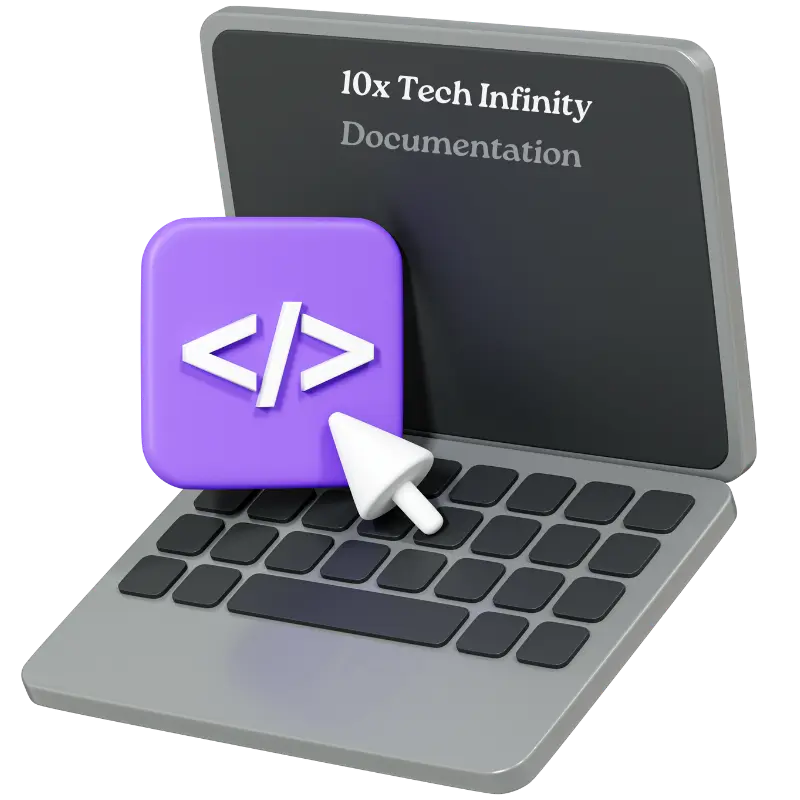Write Your First Program in C++
Welcome to our comprehensive guide on programming fundamentals! Whether you’re a complete beginner or looking to brush up on your skills, this post will take you through essential concepts in programming, with a focus on C++. We’ll cover everything from why we need programming languages to advanced topics like type conversion and number systems.
Introduction to Programming
1. Why do we need programming languages?
Programming languages are the bridge between human thoughts and computer operations. They allow us to:
- Give instructions to computers
- Solve complex problems
- Create software applications
- Automate tasks
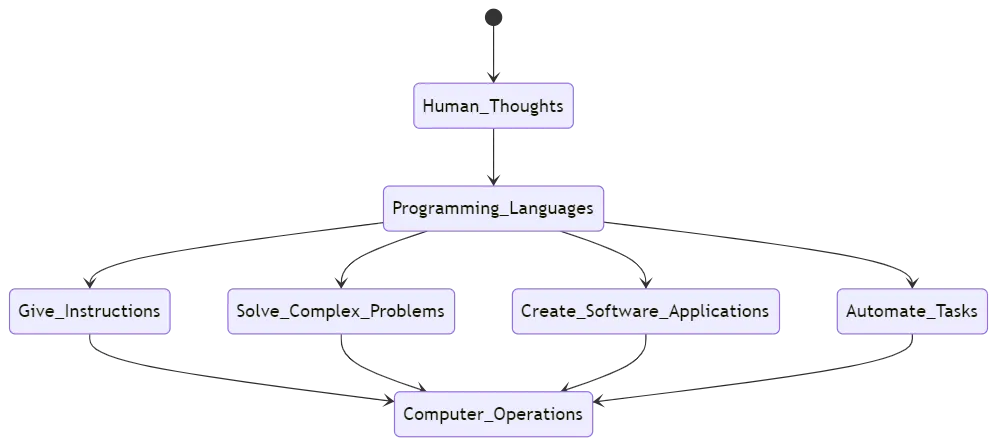
Understanding Compilers and Interpreters
1. Compiler vs Interpreter
-
Compiler: A compiler translates the entire code at once, creating an executable file, and generally executes faster, with examples including C and C++.
-
Interpreter: An interpreter translates code line by line, doesn’t create a separate file, and generally executes slower, with examples including Python and JavaScript.
Comparison Table
Here’s a table comparing compilers and interpreters based on various parameters:
| Parameter | Compiler | Interpreter |
|---|---|---|
| Translation Time | Before execution | During execution |
| Execution Speed | Generally faster | Generally slower |
| Intermediate Object Code | Generated | Not generated |
| Debugging | More difficult | Easier |
| Memory Efficiency | More efficient | Less efficient |
| Portability | Machine dependent | Machine independent |
| Error Display | All at once after compilation | Line by line during execution |
| Flexibility | Less flexible | More flexible |
| Execution | Separate compilation and execution phases | Translation and execution are intertwined |
| Use Case | Large, performance-critical applications | Scripting, rapid prototyping |
2. How does a compiler work?
- Reads the entire source code
- Checks for errors
- Translates to machine code
- Creates an executable file
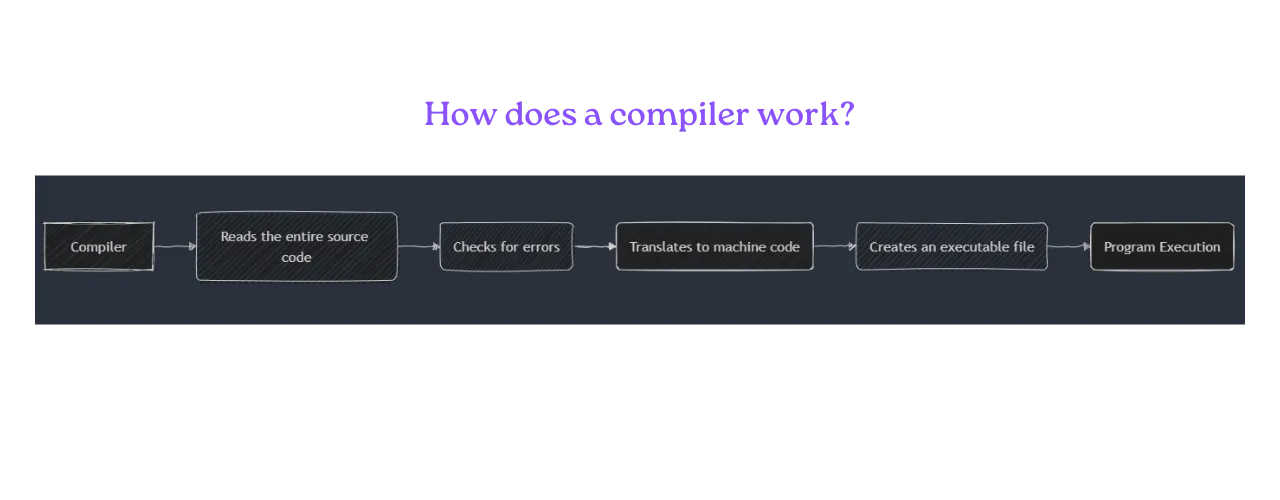
3. How does an interpreter work?
- Reads code line by line
- Translates each line to machine code
- Executes immediately
- Repeats for each line
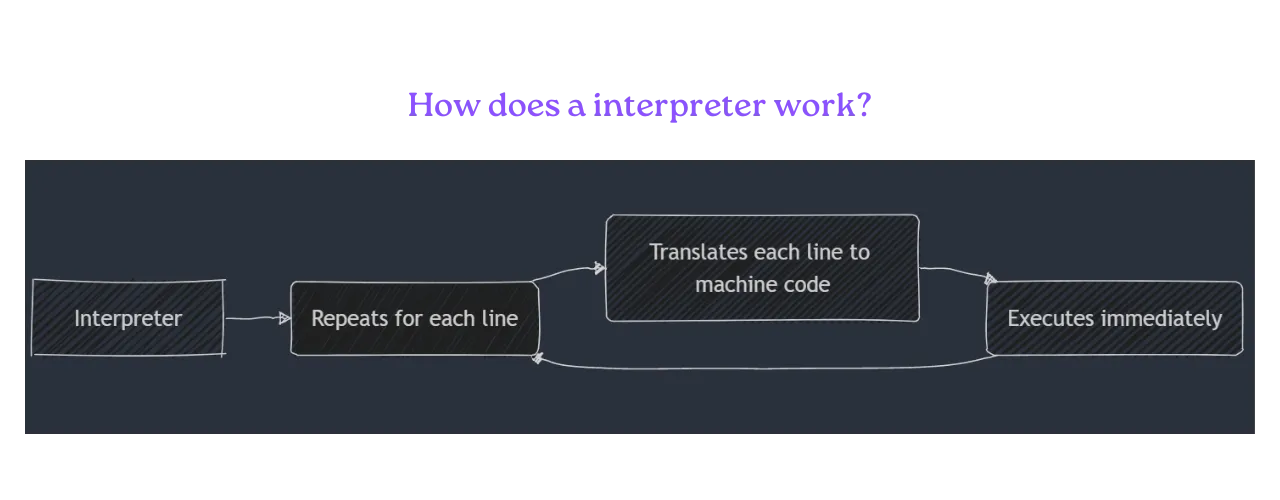
Understanding the differences between compilers and interpreters helps in choosing the right approach for your programming needs. Compiled languages are often preferred for system-level programming and performance-critical applications, while interpreted languages are great for scripting, web development, and rapid prototyping.
Getting Started with C++
1. C++ Compilation and Execution Process
- Writing C++ Code:
- Developers write C++ code using a text editor or an Integrated Development Environment (IDE).
- The code is saved with a
.cppextension.
- Preprocessing:
- The preprocessor handles directives like
#include,#define, and conditional compilation statements. - It expands macros and includes header files.
- Compilation:
- The C++ compiler translates the preprocessed code into assembly language.
- It checks for syntax errors and performs optimizations.
- Assembly:
- The assembler converts the assembly code into object code (machine code).
- This results in a
.oor.objfile.
- Linking:
- The linker combines the object files with library files.
- It resolves external references and creates the final executable file.
- Execution:
- The operating system loads the executable into memory.
- The program is then executed, following the instructions in the machine code.
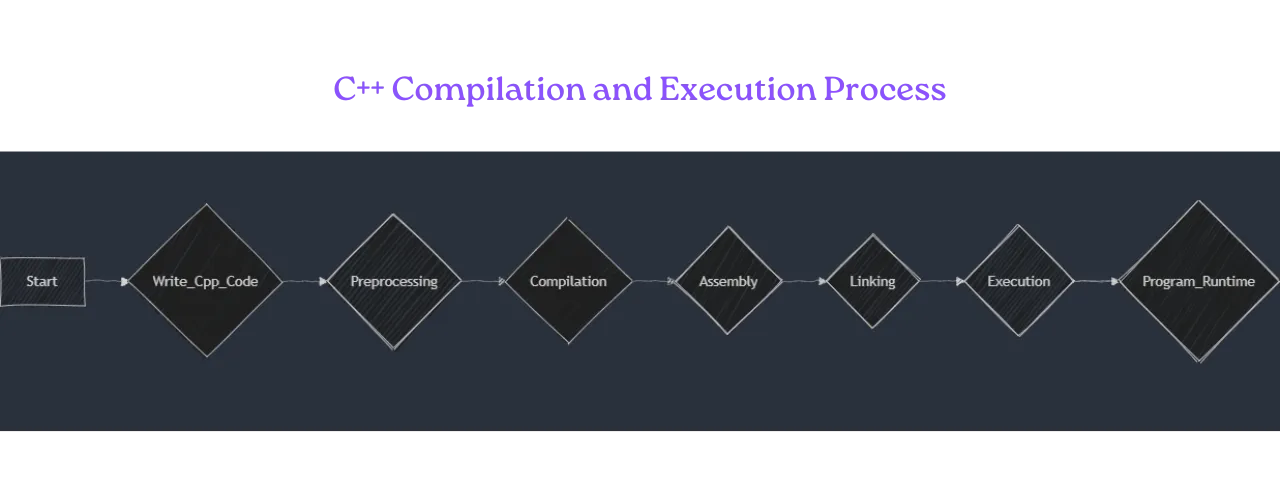
2. Where to code?
You can write C++ code using:
- Integrated Development Environments (IDEs) like Visual Studio or Code::Blocks
- Text editors like Notepad++ or Sublime Text
- Online compilers for quick testing
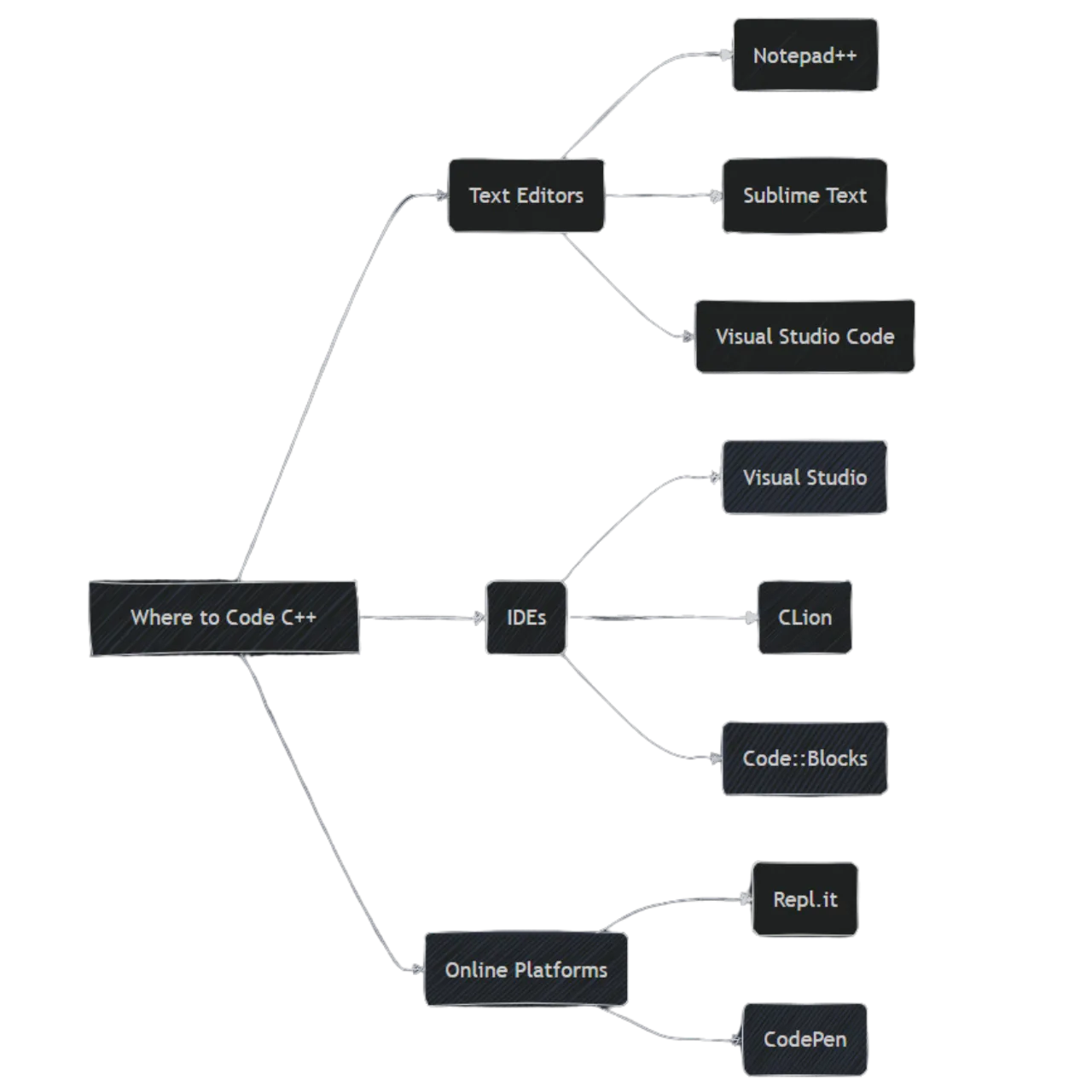
3. Tips for Beginners
- Start with a simple text editor or online platform to focus on learning the language.
- As you progress, consider moving to an IDE for more advanced features.
- Experiment with different environments to find what works best for you.
- Don’t forget to install a C++ compiler if your chosen environment doesn’t include one.
Choosing the right coding environment can significantly impact your productivity and learning experience. Consider your needs and preferences when selecting where to code in C++.
4. Let’s write down the first program in C++
Here’s a simple “Hello, World!” program in C++:
#include <iostream>
int main() { std::cout << "Hello, World!" << std::endl; return 0;}Step-by-Step Explanation
#include <iostream>:
- This line includes the input/output stream library.
- It allows us to use
coutfor output.
int main():
- This is the main function, the entry point of every C++ program.
intindicates that the function will return an integer value.
std::cout << "Hello, World!" << std::endl;:
std::coutis used to output text to the console.<<is the output operator, used to send data tocout."Hello, World!"is the string we want to print.std::endladds a newline character and flushes the output buffer.
return 0;:
- This statement returns 0 to the operating system.
- It indicates that the program executed successfully.
- Curly Braces
{ }:
- These define the scope of the main function.
- All code for the main function goes between these braces.
Key Points
- Every C++ program must have a
main()function. - The
iostreamlibrary is essential for basic input and output operations. std::is the standard namespace prefix. You can avoid typing it repeatedly by usingusing namespace std;at the beginning of your program.- Semicolons
;are used to end statements in C++.
Running the Program
- Save the code in a file with a
.cppextension (e.g.,hello_world.cpp). - Compile the program using a C++ compiler (e.g.,
g++ hello_world.cpp -o hello_world). - Run the compiled program (e.g.,
./hello_worldon Unix-like systems orhello_world.exeon Windows).
Writing your first C++ program is an exciting step in your programming journey. This simple “Hello, World!” program introduces you to the basic structure of C++ code and sets the foundation for more complex programs you’ll write in the future.
Fundamental Concepts in C++
1. What is a Variable?
A variable is a named storage location in the computer’s memory. It has a name, a type, and a value.
Declaring Variables:
int age; // Declares an integer variable named 'age'double salary; // Declares a double variable named 'salary'char grade; // Declares a character variable named 'grade'Initializing Variables:
int age = 25; // Declares and initializes 'age' to 25double salary = 50000.50; // Declares and initializes 'salary'char grade = 'A'; // Declares and initializes 'grade'2. Variables Naming Rules
When naming variables in programming, follow these rules:
- Start with a letter or underscore: Variables can’t begin with numbers or special characters.
- Use alphanumeric characters and underscores: Letters (a-z, A-Z), numbers (0-9), and underscores (_) are allowed.
- No spaces: Use underscores (my_variable) or camelCase (myVariable) to separate words.
- Case-sensitive: myVariable and myvariable are different.
- Avoid reserved keywords: Don’t use words like int, class, or return.
3. What are the Data Types?
Data types define the kind of values that a variable can hold in programming. It means, variables are containers for storing data. C++ has several data types:
1. Primitive Data Types:
Integer Types:
1. int: Whole numbers (e.g., -5, 0, 100)2. short: Smaller range of whole numbers3. long: Larger range of whole numbersFloating-Point Types:
1. float: Single-precision floating-point numbers2. double: Double-precision floating-point numbersCharacter Type:
1. char: Single characters (e.g., 'A', '7', '$')Boolean Type:
1. bool: True or false values2. Derived Data Types:
1. Arrays: Collection of elements of the same type2. Pointers: Store memory addresses3. References: Alias for another variable3. User-Defined Data Types:
1. Structures: Group different data types under one name2. Classes: Basic unit of Object-Oriented Programming3. Enumerations: User-defined type consisting of named constantsKey Points
- Choose the appropriate data type to ensure efficient memory usage.
- Variables must be declared before they can be used.
- C++ is a statically-typed language, meaning variable types are checked at compile-time.
- The size of data types can vary depending on the system and compiler.
Example Usage
#include <iostream>using namespace std;
int main() { int age = 25; double height = 5.9; char initial = 'J'; bool isStudent = true;
cout << "Age: " << age << endl; cout << "Height: " << height << " feet" << endl; cout << "Initial: " << initial << endl; cout << "Is a student: " << (isStudent ? "Yes" : "No") << endl;
return 0;}Understanding variables and data types is fundamental in C++ programming. They form the building blocks of your programs, allowing you to store and manipulate data effectively.
4. How data is stored in C++
Understanding how data is stored in C++ is crucial for efficient memory management and optimizing your programs. Let’s explore this concept through code examples and a diagram.
Data is stored in the computer’s memory as binary
(0s and 1s). Different data types use different amounts of memory.
Data Storage Diagram
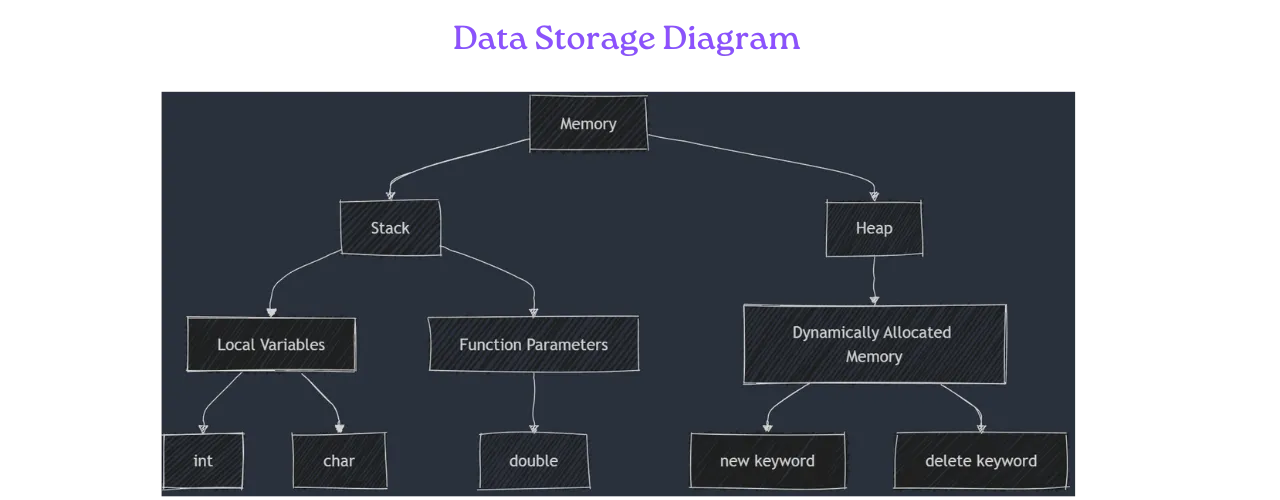
Code Example
#include <iostream>using namespace std;
int globalVar = 10; // Stored in the data segment
void exampleFunction(int parameter) { // parameter stored on stack int localVar = 20; // Stored on stack static int staticVar = 30; // Stored in data segment int* heapVar = new int(40); // Pointer on stack, int on heap
cout << "Local Variable: " << localVar << endl; cout << "Parameter: " << parameter << endl; cout << "Heap Variable: " << *heapVar << endl;
delete heapVar; // Free heap memory}
int main() { exampleFunction(50); return 0;}Explanation
1. Stack Memory:
- Used for local variables and function parameters.
- Automatically managed (allocated/deallocated) by the compiler.
- Fast access, but limited size.
- In the example:
localVar,parameter
2. Heap Memory:
- Used for dynamic memory allocation.
- Managed by the programmer (using
newanddelete). - Slower access, but larger size.
- In the example: memory allocated by
new int(40)
3. Data Segment:
- Used for global and static variables.
- Exists for the entire runtime of the program.
- In the example:
globalVar,staticVar
4. Code Segment:
- Stores the compiled program code.
- Read-only.
Key Points
1. Stack Variables:
- Automatically deallocated when they go out of scope.
- Size must be known at compile time.
2. Heap Variables:
- Must be manually deallocated to prevent memory leaks.
- Size can be determined at runtime.
3. Pointers:
- Store memory addresses.
- Used to access heap memory.
4. Memory Management:
- Proper management is crucial to prevent leaks and optimize performance.
- Use smart pointers in modern C++ for safer heap memory management.
Understanding how data is stored helps in writing more efficient and bug-free code. It’s particularly important when dealing with large data structures, optimizing memory usage, and managing resources in complex programs.
5. Signed and unsigned data types in C++
- Signed: Can represent positive and negative numbers
- Unsigned: Can only represent positive numbers (including zero)
Common Signed and Unsigned Types
| Type | Signed Range | Unsigned Range |
|---|---|---|
| char | -128 to 127 | 0 to 255 |
| short | -32,768 to 32,767 | 0 to 65,535 |
| int | -2,147,483,648 to 2,147,483,647 | 0 to 4,294,967,295 |
| long | -9,223,372,036,854,775,808 to 9,223,372,036,854,775,807 | 0 to 18,446,744,073,709,551,615 |
Note: The exact size can vary depending on the system and compiler.
Code Example
#include <iostream>#include <climits>using namespace std;
int main() { // Signed integers signed int signedInt = -10; int regularInt = 20; // By default, int is signed
// Unsigned integer unsigned int unsignedInt = 30;
cout << "Signed int: " << signedInt << endl; cout << "Regular int (signed): " << regularInt << endl; cout << "Unsigned int: " << unsignedInt << endl;
// Demonstrating ranges cout << "Signed int range: " << INT_MIN << " to " << INT_MAX << endl; cout << "Unsigned int range: 0 to " << UINT_MAX << endl;
// Overflow example unsigned int maxUnsigned = UINT_MAX; cout << "Max unsigned int: " << maxUnsigned << endl; cout << "Max unsigned int + 1: " << maxUnsigned + 1 << endl; // Wraps around to 0
return 0;}Key Points
1. Default Signedness:
int,short,long, andlong longare signed by default.charcan be signed or unsigned by default, depending on the compiler.
2. Choosing Between Signed and Unsigned:
- Use unsigned when you know the value will never be negative (e.g., array indices, sizes).
- Use signed when the value could be negative or when performing arithmetic that could result in negative values.
3. Overflow Behavior:
- Signed overflow leads to undefined behavior.
- Unsigned overflow wraps around (modulo arithmetic).
4. Conversion Rules:
- When mixing signed and unsigned in expressions, signed values are typically converted to unsigned.
- This can lead to unexpected results, so be cautious when mixing types.
5. Memory Usage:
- Both signed and unsigned types of the same base type (e.g.,
int) use the same amount of memory.
6. Performance:
- In most cases, there’s no significant performance difference between signed and unsigned types.
Understanding signed and unsigned data types helps in choosing the right type for your data, avoiding overflow issues, and writing more robust code. Always consider the range of values your variables need to represent when deciding between signed and unsigned types.
6. Operators in C++
Operators in C++ are symbols that tell the compiler to perform specific mathematical or logical manipulations. Understanding these operators is crucial for writing effective C++ code.
Types of Operators
1. Arithmetic Operators: Used for mathematical calculations
int a = 10, b = 3;cout << "Addition: " << a + b << endl; // 13cout << "Subtraction: " << a - b << endl; // 7cout << "Multiplication: " << a * b << endl; // 30cout << "Division: " << a / b << endl; // 3cout << "Modulus: " << a % b << endl; // 12. Relational Operators: Used for comparing values
int x = 5, y = 8;cout << "Equal to: " << (x == y) << endl; // 0 (false)cout << "Not equal to: " << (x != y) << endl; // 1 (true)cout << "Greater than: " << (x > y) << endl; // 0 (false)cout << "Less than: " << (x < y) << endl; // 1 (true)cout << "Greater than or equal: " << (x >= y) << endl; // 0 (false)cout << "Less than or equal: " << (x <= y) << endl; // 1 (true)3. Logical Operators: Used for logical operations
bool p = true, q = false;cout << "AND: " << (p && q) << endl; // 0 (false)cout << "OR: " << (p || q) << endl; // 1 (true)cout << "NOT: " << (!p) << endl; // 0 (false)4. Bitwise Operators: Perform operations on individual bits
int m = 5, n = 3;cout << "Bitwise AND: " << (m & n) << endl; // 1cout << "Bitwise OR: " << (m | n) << endl; // 7cout << "Bitwise XOR: " << (m ^ n) << endl; // 6cout << "Bitwise NOT: " << (~m) << endl; // -6cout << "Left Shift: " << (m << 1) << endl; // 10cout << "Right Shift: " << (m >> 1) << endl; // 25. Assignment Operators: Used to assign values to variables
int z = 10;z += 5; // Equivalent to z = z + 5cout << "After += : " << z << endl; // 15z -= 3; // Equivalent to z = z - 3cout << "After -= : " << z << endl; // 12z *= 2; // Equivalent to z = z * 2cout << "After *= : " << z << endl; // 24z /= 4; // Equivalent to z = z / 4cout << "After /= : " << z << endl; // 6z %= 4; // Equivalent to z = z % 4cout << "After %= : " << z << endl; // 27. Miscellaneous Operators: Other useful operators
int arr[5];cout << "Size of array: " << sizeof(arr) << " bytes" << endl;
int num = 42;int* ptr = #cout << "Address of num: " << ptr << endl;cout << "Value of num: " << *ptr << endl;
int result = (num > 0) ? 100 : -100;cout << "Ternary result: " << result << endl; // 100Key Points
- Operator Precedence: Operators have different precedence levels. Use parentheses to ensure operations are performed in the desired order.
- Short-Circuit Evaluation: Logical AND (&&) and OR (||) operators use short-circuit evaluation, which can be useful for efficiency and avoiding null pointer dereferences.
- Overflow: Be cautious of integer overflow when using arithmetic operators, especially with unsigned types.
- Type Conversion: When operators are used with different data types, C++ performs implicit type conversion, which can sometimes lead to unexpected results.
Understanding and correctly using operators is fundamental to writing efficient and bug-free C++ code. They allow you to perform complex calculations, make decisions, and manipulate data in various ways.
Advanced Topics
1. Number Systems In Detail
Understanding different number systems is crucial in computer science and programming. Let’s explore the two most common number systems used in computing: Binary and Decimal, and then discuss the difference between 32-bit and 64-bit processors.
Binary and Decimal
1. Decimal System (Base 10)
- The system we use in everyday life.
- Uses 10 digits: 0-9
- Each digit position represents a power of 10
Example:
123 (decimal) = 1*10^2 + 2*10^1 + 3*10^0 = 100 + 20 + 32. Binary System (Base 2)
- Used by computers for all internal operations.
- Uses 2 digits: 0 and 1
- Each digit position represents a power of 2
Example:
1011 (binary) = 1*2^3 + 0*2^2 + 1*2^1 + 1*2^0 = 8 + 0 + 2 + 1 = 11 (decimal)Converting Between Binary and Decimal
1. Decimal to Binary:
- Divide the number by 2 repeatedly.
- Read the remainders from bottom to top.
Example: Convert 13 to binary
13 ÷ 2 = 6 remainder 16 ÷ 2 = 3 remainder 03 ÷ 2 = 1 remainder 11 ÷ 2 = 0 remainder 1
Result: 13 (decimal) = 1101 (binary)2. Binary to Decimal:
- Multiply each digit by its positional value (power of 2) and sum.
Example: Convert 1101 to decimal
1101 = (1 * 2^3) + (1 * 2^2) + (0 * 2^1) + (1 * 2^0) = 8 + 4 + 0 + 1 = 13 (decimal)2. 32-bit vs 64-bit Processors
The terms 32-bit and 64-bit refer to the width of the CPU register, which affects how much data the processor can handle at once.
Comparison Table
| Feature | 32-bit Processor | 64-bit Processor |
|---|---|---|
| Register Size | 32 bits | 64 bits |
| Max Addressable Memory | 4 GB (2^32 bytes) | 18.4 million TB (2^64 bytes) |
| Integer Range | -2,147,483,648 to 2,147,483,647 | -9,223,372,036,854,775,808 to 9,223,372,036,854,775,807 |
| Floating Point Precision | Single precision (32 bits) | Double precision (64 bits) |
| Performance | Lower for large data sets | Higher for large data sets |
| Software Compatibility | Can run 16-bit and 32-bit software | Can run 32-bit and 64-bit software (with proper support) |
Key Points
- Memory Addressing: 64-bit processors can address vastly more memory, which is crucial for memory-intensive applications.
- Data Processing: 64-bit processors can handle larger numbers and perform operations on 64-bit data in a single cycle.
- Software Compatibility: 64-bit systems can run most 32-bit software, but 32-bit systems cannot run 64-bit software.
- Performance: 64-bit processors generally offer better performance, especially for applications that require handling large amounts of data.
Understanding number systems and processor architectures is fundamental in computer science. It helps in optimizing code, understanding memory limitations, and making informed decisions about hardware and software compatibility.
3. Type Conversion (Type Casting)
Type conversion, also known as type casting, is the process of converting data from one data type to another. In C++, type conversion can be either implicit (automatic) or explicit (manual). Understanding type conversion is crucial for writing efficient and error-free code.
Why Type Conversion?
- To use a value in a different context (e.g., using an integer in a floating-point calculation).
- To prevent data loss or unexpected behavior in operations involving different data types.
- To explicitly change the interpretation of data (e.g., treating bytes as characters).
Types of Type Conversion
- Widening or Automatic Type Conversion (Implicit)
- Narrowing or Explicit Type Conversion (Explicit)
I. Widening or Automatic Type Conversion
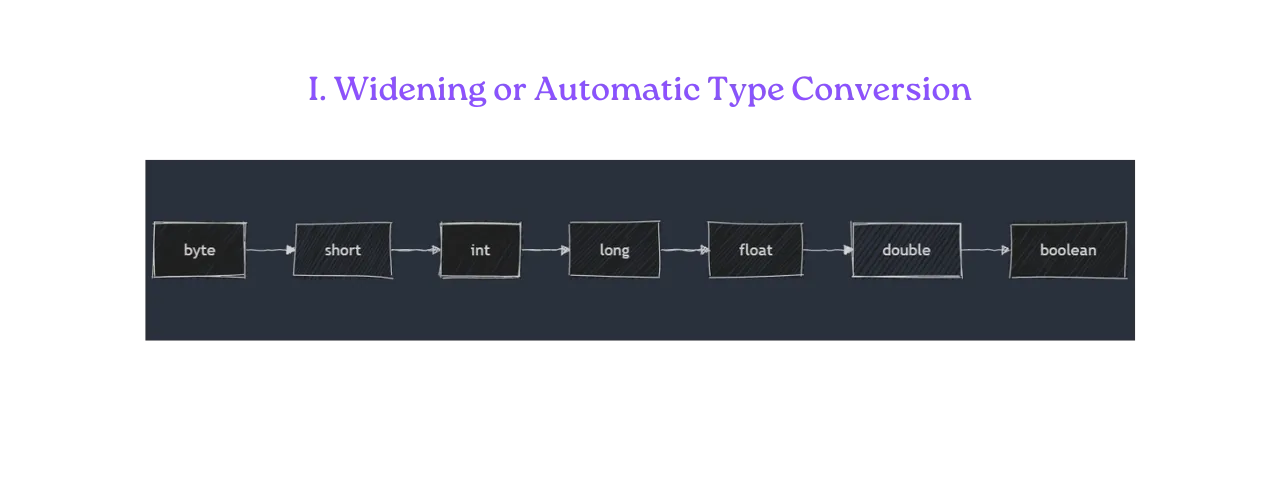
This occurs when a value of a smaller data type is assigned to a larger data type. The compiler performs this conversion automatically without any loss of data.
Occurs when a smaller data type is converted to a larger data type automatically.
Example
int intValue = 10;double doubleValue = intValue; // Automatic conversion from int to double
cout << "Int value: " << intValue << endl;cout << "Double value: " << doubleValue << endl;II. Narrowing or Explicit Type Conversion
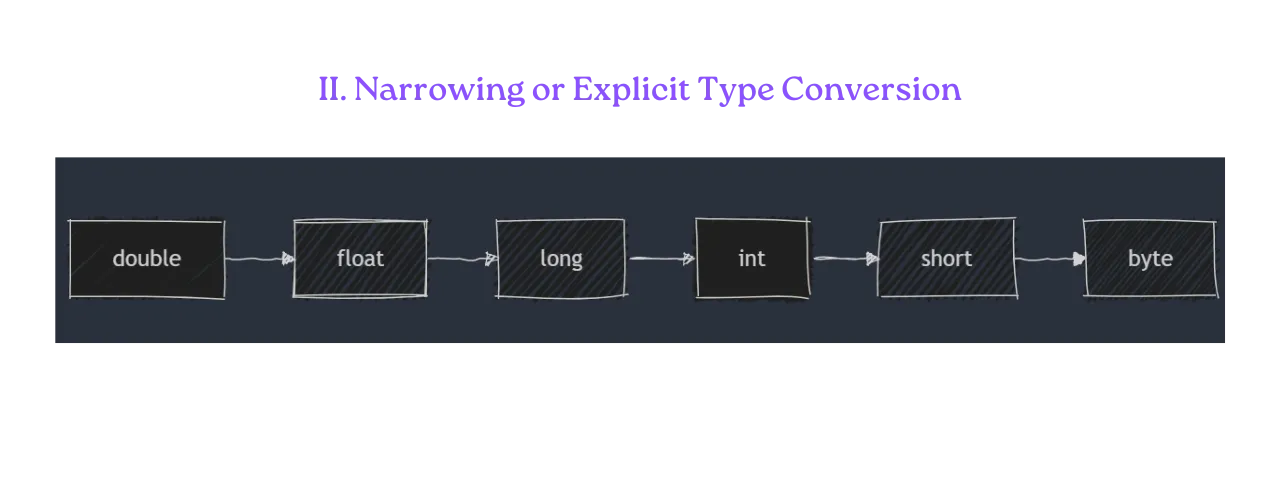
This occurs when a value of a larger data type is assigned to a smaller data type. This can lead to data loss and must be done explicitly by the programmer.
Occurs when a larger data type is converted to a smaller data type, requiring explicit instruction.
Methods of Explicit Type Conversion:
1. C-style Cast:
double pi = 3.14159;int intPi = (int)pi; // C-style cast2. Function-style Cast:
float floatValue = float(intValue); // Function-style cast3. Static Cast (Recommended in modern C++):
long longValue = 1000000;int intValue = static_cast<int>(longValue);Example
#include <iostream>using namespace std;
int main() { double largeNumber = 1234567.89; int smallerNumber = static_cast<int>(largeNumber);
cout << "Original double: " << largeNumber << endl; cout << "Converted to int: " << smallerNumber << endl;
// Potential data loss long long veryLargeNumber = 9223372036854775807LL; // Maximum value for long long int muchSmallerNumber = static_cast<int>(veryLargeNumber);
cout << "Very large number: " << veryLargeNumber << endl; cout << "Converted to int (with data loss): " << muchSmallerNumber << endl;
return 0;}Key Points
-
Data Loss: Be cautious of data loss when converting from larger to smaller types or from floating-point to integer types.
-
Precision: Converting between floating-point types may result in loss of precision.
-
Sign Issues: Converting between signed and unsigned types can lead to unexpected results.
-
Overflow: Be aware of potential overflow when converting between types with different ranges.
-
Best Practices:
1. Use `static_cast` for most type conversions in modern C++.2. Avoid C-style casts as they can hide potential issues.3. Be explicit about your intentions when performing type conversions.- Compiler Warnings: Pay attention to compiler warnings about type conversions, as they often indicate potential issues.
Understanding type conversion is essential for writing robust C++ code. It helps prevent bugs related to data loss or unexpected behavior and allows for more flexible and efficient use of different data types in your programs.
4. What is return 0?
return 0; at the end of the main function indicates that the program has executed successfully.
5. What is return 1?
return 1; (or any non-zero value) indicates that an error occurred during program execution.
Conclusion
Learning C++ and programming basics opens up a world of possibilities in software development. Remember, practice is key to mastering these concepts. Keep coding and exploring!
~~ Happy Coding
